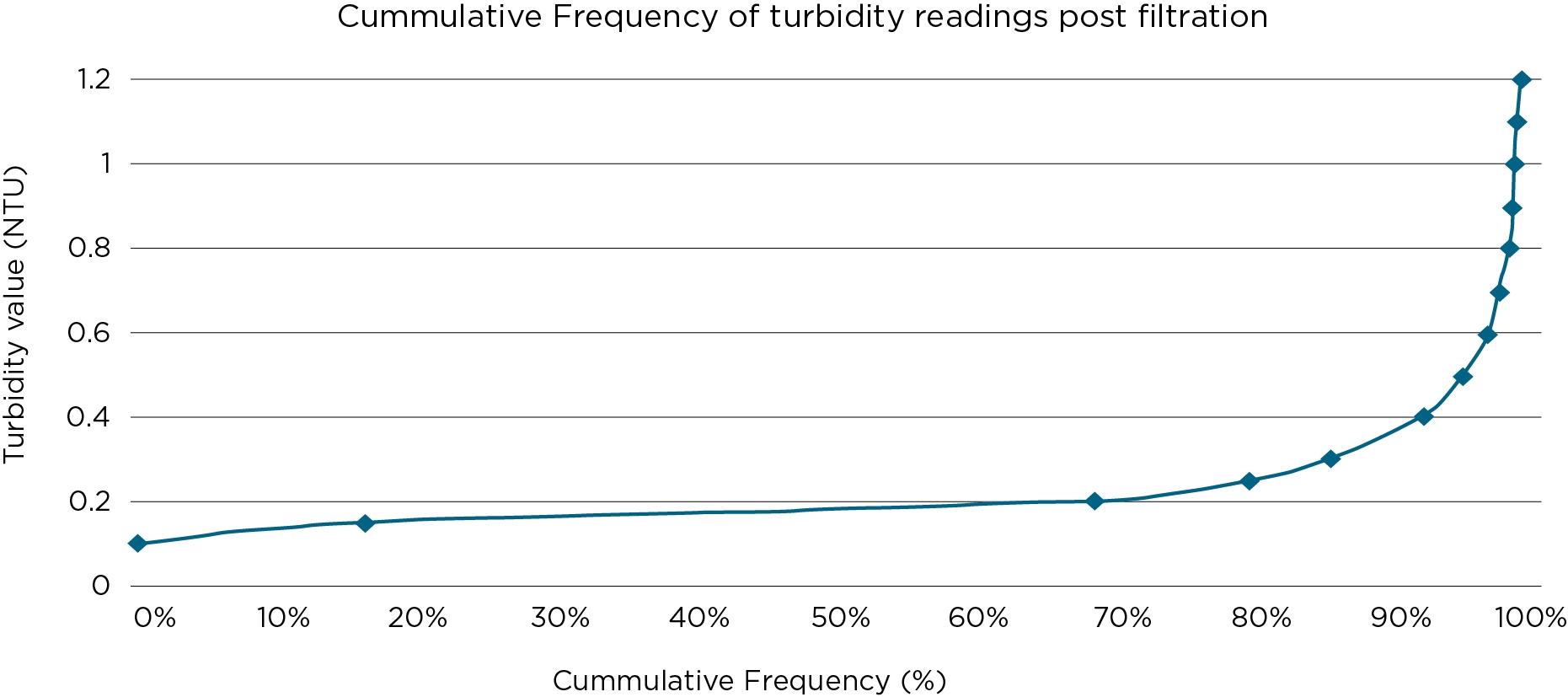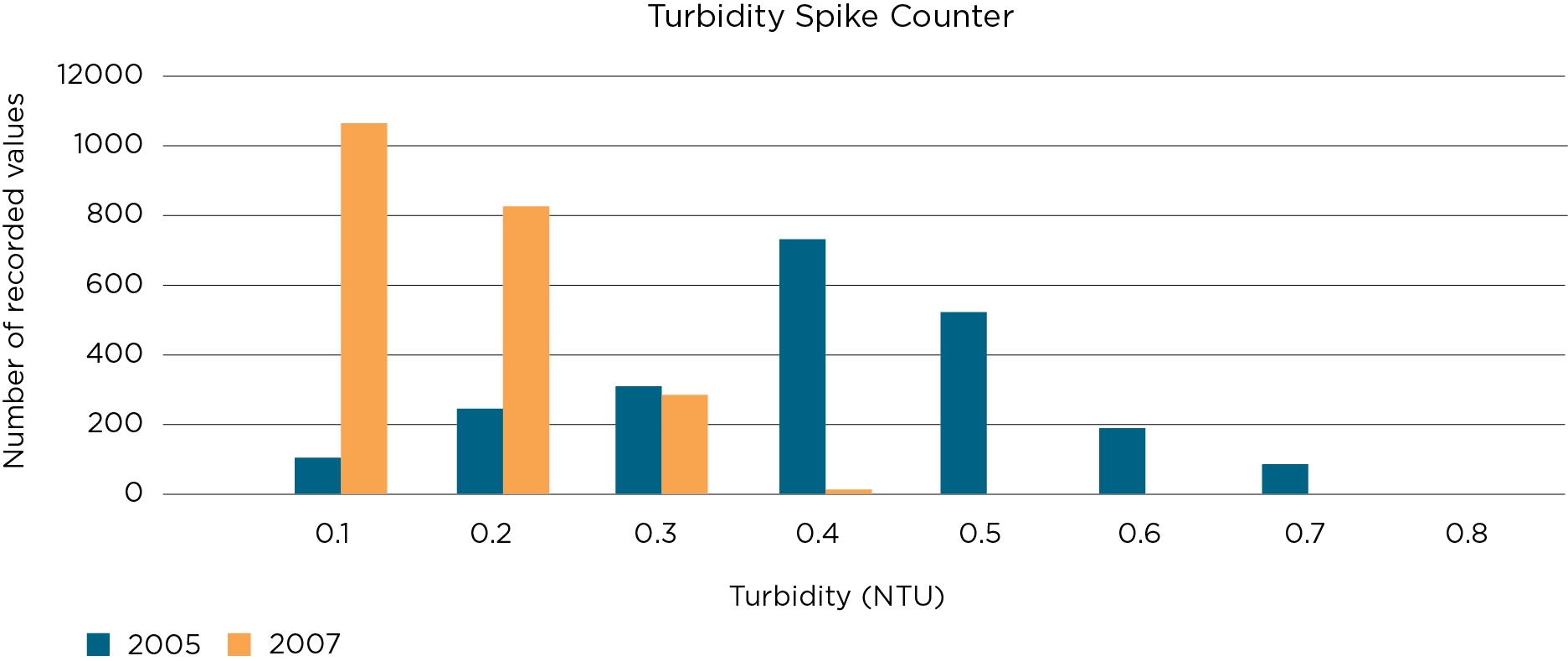10.3.1 Long-term evaluation of microbial performance
The long-term evaluation of microbial performance is a system-wide assessment that includes a performance evaluation of microbial monitoring data for the distribution system, including the point of supply to consumers, over a defined period, supplemented by all available operational monitoring data relevant to microbial system performance, from catchment to consumer. The purpose is to confirm the robustness of the system to deliver, reliably and continuously, drinking water that is free of microbial contamination.
Assessment of long-term microbial performance of the water supply system is undertaken to understand microbial challenges, and assess the effectiveness of preventive measures and barrier performance and whether they are being implemented appropriately. Any unacceptable increase in risk to consumers from changes in microbial challenge, barrier performance and/or system operation should be mitigated through short- and long-term improvements.
Information from any investigations, validation monitoring or incidents that may have occurred during the period of assessment should be included in the evaluation, for insights into problems and lessons learnt.
Where the long-term evaluation indicates deficiencies or opportunities to strengthen barriers to contamination, it is essential that short-term and long-term improvements are assessed, planned and implemented as a priority.
Review of microbial monitoring within the distribution system
Assessing the microbial quality of drinking water supplied to consumers over the long term is necessary to verify system performance and identify possible vulnerabilities in the water supply system or emerging trends of concern that may have gone unnoticed. This involves primarily an evaluation of E. coli monitoring data for the distribution system, including the point of supply to consumers.
As detailed in Section 10.2.3, the performance measure is that no E. coli should be detected in drinking water. Recognising the uncertainty attached to some E. coli results, the performance measure also includes the requirement that corrective action be undertaken and documented in response to each detection, to prevent recurrences of potential faecal contamination.
E. coli results should be reported per water quality monitoring zone, detailing the number of samples collected, and the percentage of samples that were free of E. coli detections. The reporting statistics should not include results derived from repeat samples, or from emergency or investigative samples undertaken in response to detections.
In assessing and reporting on long-term microbial performance, the number of samples that contained E. coli should also be detailed. If E. coli was detected in any drinking water quality samples, the long-term review should report each investigation and the corrective actions taken.
Where a water quality monitoring zone records more than one sample positive for E. coli during the reporting period, a more detailed description of the actions taken to investigate and resolve the multiple detections should be prepared.
The rationale behind this reporting approach is that not all detections of E. coli can be directly linked to instances of faecal contamination, but all detections need to be investigated and appropriate remedial action taken.
A long-term target for E. coli may be determined in consultation with the relevant health authority or drinking water regulator.
For water systems where drinking water temperatures in service tanks/reservoirs and the distribution system can consistently reach temperatures greater than 25ºC, the long-term evaluation of microbial performance should also include a similar review of Naegleria monitoring data.
For the long-term evaluation of microbial quality, it is important to assess concurrently all operational monitoring data relevant to microbial system performance, to provide assurance of the microbial data derived from water quality monitoring and confirm the robustness of the system to meet current and foreseeable challenges. Key aspects to include in this evaluation include performance of critical control points, source water, reservoir and catchment monitoring, and distribution system integrity monitoring.
Review of critical control point performance
The continuous operation of critical control points (CCPs), such as disinfection and filtration, within target criteria and critical limits is the single most important factor in ensuring the supply of water that is free of microbial pathogens.
Performance of CCPs over the long term should be assessed against the specified target criteria and critical limits by reviewing and reporting, for example:
percentage of time, or volume of water supplied, where critical limit(s) were met;
percentage of time, or volume of water supplied, where target criteria were met;
number of alarms that occurred over the review period; and
number of shut-downs to operation that occurred over the review period due to critical limit breaches.
Water suppliers should strive to supply water that has complied with critical limit criteria 100 per cent of the time. Where any performance objectives are not met, the review should try to understand the underlying nature of the problems. Any potential upstream and downstream factors that may be associated with objectives not being met should be considered. The review should confirm whether the apparent microbial challenge is within the design specification of the treatment process.
Any documented or anecdotal reports of malfunctions or incidents at CCPs will provide additional insights into problems and the actions required to improve performance. Review of CCP performance should also include the percentage of the planned routine preventive maintenance that has been undertaken, including instrument calibration.
Corrective actions to improve performance should then be planned, implemented, and monitored.
Box 10.5 provides an example of the long-term evaluation of filtration plant performance, which is an important part of the long-term evaluation of microbial performance of the system and the ongoing provision of safe drinking water.
Example of the long-term evaluation of filter performance
Real-time turbidity monitoring is necessary to ensure that filtration is optimised and that the required pathogen removal is achieved at all times. In addition to routine review of filtration performance in the short-term to assess drinking water safety, the long-term review of filtration performance, over periods of months to years, is essential to demonstrate whether the barrier has operated effectively and continuously under a full range of challenges.
The assessment of filtration performance should include the percentage of time that target criteria and critical limits were met and whether any trends or problems can be identified. A cumulative frequency graph (Figure 10.5.1) or a frequency histogram (Figure 10.5.2) provide useful visual representations of filter performance over long time periods. Figure 10.5.1 indicates that for this particular filter, treated water met the turbidity critical limit of 0.5 NTU approximately 92% of the time, and the turbidity target criterion of 0.2 NTU approximately 65% of the time. A performance objective should be to achieve critical limits 100% of the time, while the target criterion may have some allowance for filter ripening after routine backwash events. In this example, however, the poor performance achieved from filtration, with the potential that unsafe water may have been supplied, would require that the operation of the filter be thoroughly examined and an improvement plan developed.
In conjunction with other microbial monitoring data from throughout the system, this filtration performance should be further evaluated to understand the causes of exceedances of established criteria and why corrective actions that were taken may not have been effective. Challenges from the source water, assessment of the design capabilities of the filtration plant, observational monitoring of the filters during backwash, operator training, instrument calibration, and preventive maintenance activities should also be reviewed to understand overall filtration performance, and identify improvements needed to meet current and foreseeable changes to challenges.
In Figure 10.5.2, turbidity data are compared to those from a previous year. The shift of the bars to the left in 2007 indicates improved operation and performance of the filter over time. The presentation of data in these formats provides a clear assessment of filtration performance over the long term; it allows filter problems to be identified early and provides or an early indication of deteriorating filter performance (Mosse and Murray 2008).
Figure 10.5.1 Cumulative frequency graph of filtered water turbidity

Figure 10.5.2 Turbidity histogram

Review of other operational monitoring – catchment to consumer
The long-term evaluation of microbial performance should also include a review of all other operational monitoring undertaken throughout the system. Source water (and reservoir) monitoring data should be reviewed to assess any changes in the microbial challenge to the water supply system and whether any trends of concern can be determined. Any significant hydrological or other events should be reviewed to assess any associations that may relevant to system management (e.g. the response of turbidity and E. coli to rainfall events; the response of algae to increases in reservoir water temperatures) and if a reclassification of the catchment may be required to meet microbial health-based targets (See Chapter 5).
Observational and investigative monitoring results from the catchment area should be reviewed to provide insight into changes in the level of challenge/risk (e.g. from changes in land use, recreation, climatic and natural events). Review of incident reports can also highlight any new hazards and problems, and should be incorporated in the review.
The long-term evaluation of microbial performance is supported by reviewing monitoring activities in the distribution system. Chlorine residual performance in the distribution system provides useful information on potential problems and risks that may not have been revealed through microbial monitoring. Hence, chlorine residual penetration and consistency should be evaluated and any areas of concern identified. System integrity should be verified by reviewing preventive maintenance activities, as well as any monitoring and inspection records undertaken during the period.
Risk mitigation measures or system management improvements identified from the long-term evaluation of microbial performance should be planned and implemented as necessary.